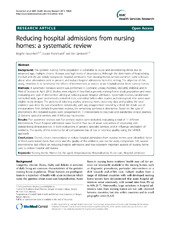| dc.description.abstract | Background: The geriatric nursing home population is vulnerable to acute and deteriorating illness due to advanced age, multiple chronic illnesses and high levels of dependency. Although the detriments of hospitalising the frail and old are widely recognised, hospital admissions from nursing homes remain common. Little is known about what alternatives exist to prevent and reduce hospital admissions from this setting. The objective of this study, therefore, is to summarise the effects of interventions to reduce acute hospitalisations from nursing homes. Methods: A systematic literature search was performed in Cochrane Library, PubMed, MEDLINE, EMBASE and ISI Web of Science in April 2013. Studies were eligible if they had a geriatric nursing home study population and were evaluating any type of intervention aiming at reducing acute hospital admission. Systematic reviews, randomised controlled trials, quasi randomised controlled trials, controlled before-after studies and interrupted time series were eligible study designs. The process of selecting studies, assessing them, extracting data and grading the total evidence was done by two researchers individually, with any disagreement solved by a third. We made use of meta-analyses from included systematic reviews, the remaining synthesis is descriptive. Based on the type of intervention, the included studies were categorised in: 1) Interventions to structure and standardise clinical practice, 2) Geriatric specialist services and 3) Influenza vaccination. Results: Five systematic reviews and five primary studies were included, evaluating a total of 11 different interventions. Fewer hospital admissions were found in four out of seven evaluations of structuring and standardising clinical practice; in both evaluations of geriatric specialist services, and in influenza vaccination of residents. The quality of the evidence for all comparisons was of low or very low quality, using the GRADE approach. Conclusions: Overall, eleven interventions to reduce hospital admissions from nursing homes were identified. None of them were tested more than once and the quality of the evidence was low for every comparison. Still, several interventions had effects on reducing hospital admissions and may represent important aspects of nursing home care to reduce hospital admissions. | en_US |

